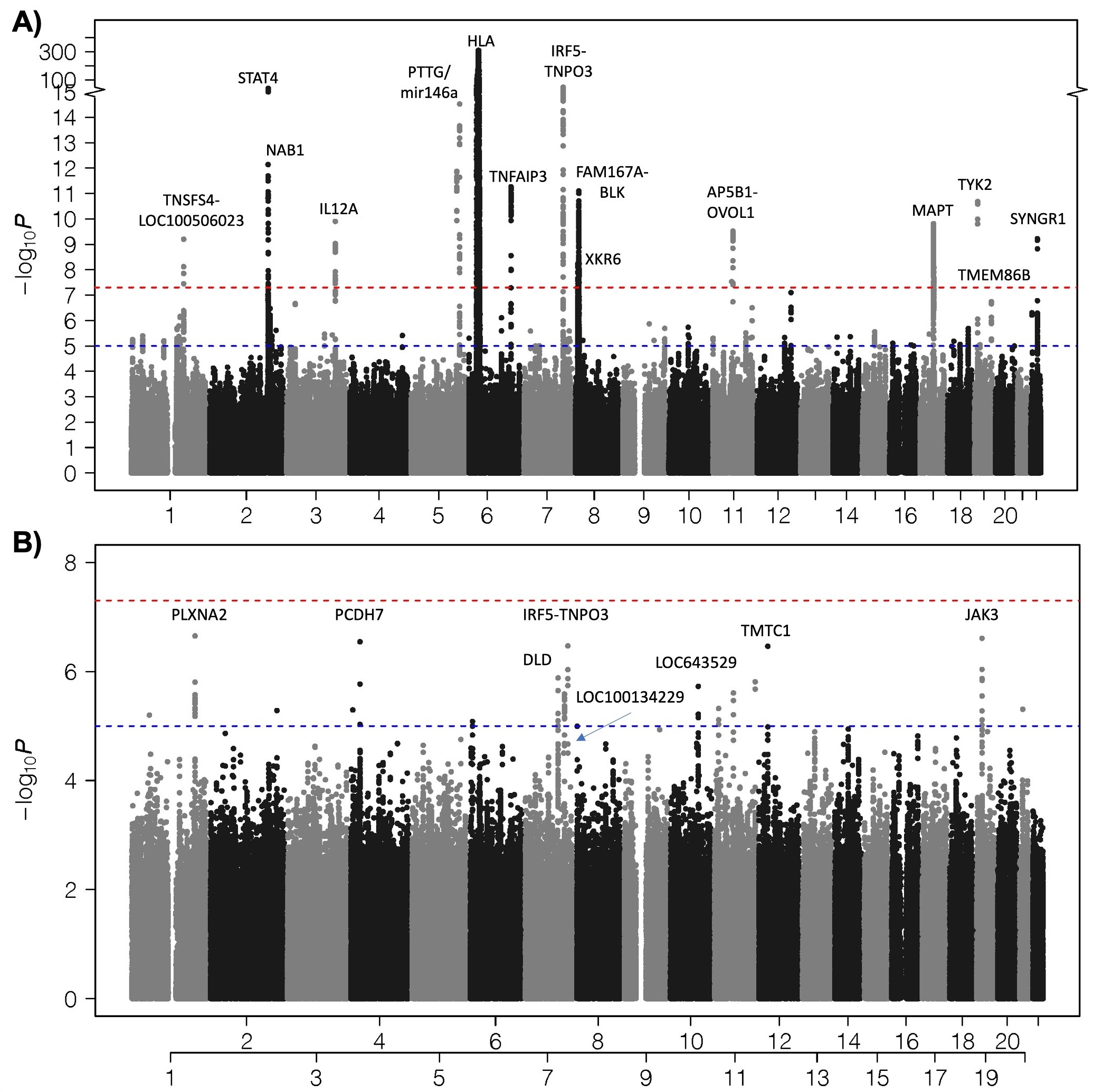Session Information
Session Type: Poster Session B
Session Time: 10:30AM-12:30PM
Background/Purpose: Sjögren’s disease (SjD) is a complex systemic autoimmune disease with 22 genome-wide significant (GWS) risk loci [1]. Historically, genomic research has focused on populations of European ancestry (86% of genome-wide association study (GWAS) populations) [2]. Only five of the 22 GWS SjD risk loci were identified using multi-ethnic, non-European populations (IRF5-TNPO3, STAT4, TNFAIP3, GTF21RD1-NCF1, IKZF1) [1]. The International Sjögren’s Genetics Network (SGENE) is focused on understanding how genetic variants influence SjD pathology. As sample sizes and ancestral diversity increase, we can improve analyses of clinical subsets, which few studies have done. The objective of this GWAS aims to identify new GWS risk loci (p< 5E-08; suggestive: p< 5x10E-5) across SjD cases of European ancestry, with and without anti-Ro/SSA antibodies (Ro/SSA).
Methods: Institutional IRB/EC approval was obtained. All cases met the 2002 AECG criteria for SjD. A cohort of 5058 cases and 25943 controls were genotyped on GWAS arrays. After sample quality control, 4855 cases and 25408 controls were analyzed by logistic regression using the first four principal components as covariates for ancestry. Analyzed subsets included Ro/SSA+ (n=2898), Ro/SSA- (n=1313) of European ancestry.
Results: GWAS results indicated different genetic architectures in Ro/SSA+ compared to Ro/SSA- cases. Ro/SSA+ cases showed significant association with the MHC region of chromosome 6 (top HLA SNP rs3130562, OR 3.66 [3.42-3.92], p=3.09E-308). This association was much lower in Ro/SSA- (top HLA SNP rs12664475, OR 1.25 [1.13-1.38], p=2.54E-5). Ro/SSA+ GWAS identified 15 GWS loci (Fig.1a). In the Ro/SSA- GWAS, none of the regions surpassed GWS threshold but 8 regions showed suggestive association: near PLXNA2, PCDH7, IRF5-TNPO3, DLD, LOC100134229, JAK3, LOC643529, and TMTC1 (Fig.1b). Only 2 of these loci (IRF5-TNPO3 and LOC643529) were in the Ro/SSA+ GWAS at the suggestive threshold. Deeper interrogation of the IRF5-TNPO3 locus revealed shared and distinct patterns, where the Ro/SSA- association was more similar to that of primary biliary cholangitis and the Ro/SSA+ association more similar to that of systemic sclerosis and lupus. The suggestive JAK3 risk locus was unique to the Ro/SSA- GWAS. Increased JAK3 expression in salivary gland epithelial cells and infiltrating immune cells was identified in SjD [3]. The Ro/SSA- GWAS risk SNPs are eQTLs to JAK3 in minor salivary gland and lymphoblastoid cell lines.
Conclusion: Our findings highlight the need to study specific subphenotypes to find new loci and understand the genetic basis of SjD heterogeneity. Our ongoing efforts aim to increase the sample size of disease subsets to reach GWS for Ro/SSA- of European ancestry. We also are increasing the sample size of SjD cases from non-European ancestries, including Asian ancestry (n=915).
References: [1] Khatri, et al. Nat Commun. 2022. DOI: 10.1038/s41467-022-30773-y. [2] Fatumo, et al. Nat Med. 2022. DOI: 10.1038/s41591-021-01672-4. [3] Gupta, et al. Nat Genet. 2023. DOI: 10.1038/s41588-023-01577-7.
To cite this abstract in AMA style:
Radziszewski M, Rasmussen A, Khatri B, Tessneer K, Pontarini E, Bombardieri M, Rischmueller M, Wahren-Herlenius M, Kvarnström M, Witte T, Bootsma H, Verstappen G, Kroese F, Vissink A, Pringle S, Tzioufas A, Mavragani C, Baer A, Alarcon-Riquelme M, Martin J, Mariette X, Nocturne G, Pers J, Gottenberg J, Ng W, Shiboski C, Taylor K, Criswell L, Warner B, Farris A, James J, Scofield R, Guthridge J, Wallace D, Venuturupalli S, Brennan M, Imgenberg-Kreuz J, Rönnblom L, Baecklund E, Eloranta M, Aqrawi L, Palm Ø, Brun J, Hammenfors D, Jonsson M, Appel S, Magnusson Bucher S, Forsblad-d'Elia H, Mandl T, Lessard C. Genetic Architecture Divergence in Sjögren’s Disease Subphenotypes and Populations: Genome-wide Association Study of Ro/SSA+ and Ro/SSA- Cases in European Populations [abstract]. Arthritis Rheumatol. 2024; 76 (suppl 9). https://acrabstracts.org/abstract/genetic-architecture-divergence-in-sjogrens-disease-subphenotypes-and-populations-genome-wide-association-study-of-ro-ssa-and-ro-ssa-cases-in-european-populations/. Accessed .« Back to ACR Convergence 2024
ACR Meeting Abstracts - https://acrabstracts.org/abstract/genetic-architecture-divergence-in-sjogrens-disease-subphenotypes-and-populations-genome-wide-association-study-of-ro-ssa-and-ro-ssa-cases-in-european-populations/

